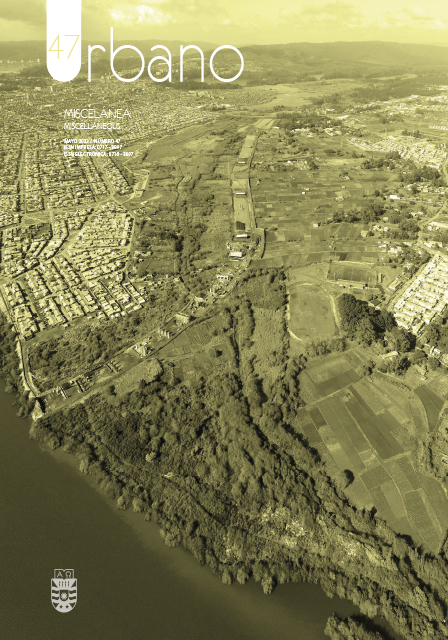From a political to an im-political community: The end of the company town (Tocopilla, Chile, 1915-1996)
DOI:
https://doi.org/10.22320/07183607.2023.26.47.05Keywords:
company town, Santiago de Chile, electricity generation, Tocopilla, im-politicsAbstract
By using a historical and anthropological methodology, this paper describes and analyzes the urban case study of Tocopilla, Chile, a city that, as a result of the industrialization of the Chuquicamata mine in 1915 by The Chile Exploration Company, saw the installation of a powerful thermoelectric power plant that included a Company town, which operated under the same rules as the Chuquicamata camp. The thermoelectric plant, nationalized in 1971, remained under the management of CODELCO, before being privatized in 1996. Thus, the new company dissociated itself from the paternalistic control of workers and their housing, permitting the emergence of a process that brought an end to the Company town. This paper looks to characterize the organizational, material, and semantic transition seen in the settlement since 1996, understood as a process that took place under a neoliberal setting, which the authors have called the transition from a political to an im-political community.
Downloads
References
AGAMBEN, G. (2003). Homo Sacer II. Primera parte. Estado de excepción. Buenos Aires: Adriana Hidalgo.
AUGÉ, M. (2005). Los no lugares. Espacios del anonimato. Una antropología de la sobremodernidad. Barcelona: Editorial Gedisa.
BOURDIEU, P. (2003). Capital cultural, escuela y espacio social. Buenos Aires: Editorial Siglo XXI.
ESPÓSITO, R. (2003). Communitas. Origen y destino de la comunidad. Buenos Aires: Ed. Amorrortu.
ESPÓSITO, R. (2006). Categorías de lo im-político. Buenos Aires: Editorial Katz.
FUENTES, P. & CERDA, G. (2020). Ciudad resignificada. Arquitecturas del Sur, 38(58), 04–05. DOI: https://doi.org/10.22320/07196466.2020.38.058.00
GALAZ-MANDAKOVIC, D. (2013). Tocopilla Norte: imágenes y memoria. Tocopilla: Retruécanos Ediciones, Ministerio de Vivienda y Urbanismo y Municipalidad de Tocopilla. Recuperado de: https://www.researchgate.net/publication/277022241_Tocopilla_Norte_imagenes_y_memoria?channel=doi&linkId=555fe01008ae6f4dcc927356&showFulltext=true
GALAZ-MANDAKOVIC, D. (2017). Inclusions, transformations et asymétries du capitalisme minier sur la cote d’Atacama: les dérives de la production thermoélectrique a Tocopilla (Chili) 1914-2015. Instituto de Arqueología y Antropología, Universidad Católica del Norte (Chile) y Université Rennes 2 (France). PhD Thesis. DOI: http://www.theses.fr/2017REN20069
GALAZ-MANDAKOVIC, D. (2020a). Una transformación urbana en la costa del Desierto de Atacama desde 1929: derivaciones de las visitas del presidente Carlos Ibáñez y los urbanistas Karl Brunner y Luis Muñoz Maluschka a Tocopilla, Chile. Revista de Urbanismo, (43), 168-186. DOI: https://doi.org/10.5354/0717-5051.2020.57001
GALAZ-MANDAKOVIC, D. (2020b). The Guggenheim process. Innovaciones y contrapuntos de un sistema técnico y de transporte en la industria del salitre en el Departamento de Tocopilla (Chile, 1926-1949). Revista de Historia, 27(2), 175-209. DOI: https://dx.doi.org/10.29393/rh27-15gpdg10015
GALAZ-MANDAKOVIC, D. & RIVERA, F. (2021). Anti-communism, labour exploitation, and racism at the thermoelectric plant of the world’s largest copper mine (Tocopilla, Chile, 1948-1958). Labor History, 62 (5-6), 614-631. DOI: https://doi.org/10.1080/0023656X.2021.1925639
GALAZ-MANDAKOVIC, D. & TAPIA, V. (2022). El panteón de la montaña de cobre. Trabajo, ambiente y causas de muerte en lamina de Chuquicamata durante la etapa Guggenheim (Chile, 1915–1923). História Unisinos, 26(2), 312–329. DOI: https://doi.org/10.4013/hist.2022.262.10
GRAVANO, A. (2009). Antropología de lo barrial. Estudios sobre producción simbólica de la vida urbana. Buenos Aires: Espacio Editorial.
GUDIÑO, P. (2011). Comunidad de lo (im)político: Ser con la otredad. Andamios, 8(16), 33-48. Recuperado de: http://www.scielo.org.mx/scielo.php?script=sci_arttext&pid=S1870-00632011000200003
GUTIÉRREZ, E. & FIGUEROA, M. (1920). Chuquicamata: Su grandeza y sus dolores. Santiago de Chile: Imprenta Cervantes.
HARVEY, D. (2015). Diecisiete contradicciones del capital y el fin del neoliberalismo. Quito: Editorial IAEN.
HOBSBAWM, E. (1987). El mundo del trabajo. Estudios históricos sobre la formación y evolución de la clase obrera. Barcelona: Editorial Crítica.
LE GOUILL, C. (2018). Du paternalisme industriel des company towns à la politique de Responsabilité Sociale des Entreprises Le cas de La Oroya (Pérou). Caravelle, (111), 41-58. DOI: https://doi.org/10.4000/caravelle.3680
LUCERO, J. N. (2022). Patočka frente a lo impolítico: La persona espiritual y el Estado como "enunciación de problemas”. Contrastes. Revista Internacional De Filosofía, 27(1), 61-80. DOI: https://doi.org/10.24310/Contrastescontrastes.v27i1.11234
NANCY, J. L. (2000). La Comunidad Inoperante. Santiago de Chile: Universidad Arcis.
OLIVARES, F., PRADA-TRIGO, J. & RAMOS, L. (2022). Análisis de estructuras urbanas en un Company town. Inicio, desarrollo y declive del caso “campamento nuevo”, Chuquicamata. Urbano (Concepción), 25(45), 92-111. DOI: https://dx.doi.org/10.22320/07183607.2022.25.45.08
PÉREZ, L. & VILCHES, V. (2014). Chuquicamata: crónica de un desalojo / cierre, despedida y últimos años de funcionamiento. En: López M.I. y Pérez, L. (Eds.). Patrimonio minero y sustentabilidad. Propuestas y experiencias de reutilización. Chile: Ediciones Universidad del Bío-Bío-CYTED, pp. 50-62.
SCRANTON, P. (1984). Variety of paternalism: Industrial structure and the social relations of production In American textiles. American Quarterly, 36(2), 235-257.
SIERRA, J. (1990). El Obrero Soñado: Ensayo Sobre el Paternalismo Industrial: Asturias, 1860-1917. Madrid: Editorial Siglo XXI.
TAPIA, V. & CASTRO, L. (2022). Los Pueblos libres de Chuquicamata: Su origen y su desarrollo en los albores del ciclo de la Gran Minería del Cobre en Chile (1886-1930). Estudios Atacameños, 68, e4832. DOI: https://doi.org/10.22199/issn.0718-1043-2022-0010
VILCHES, V. (2018). Chuquicamata. Evolución de la vivienda en el Campamento Nuevo. Santiago: Andros Impresores.
WEINBERG, M. (2021). Cuerpos de cobre: Extractivismo en Chuquicamata, Chile. The Journal of Latin American and Caribbean Anthropology, 26(2), 200–218. DOI: https://doi.org/10.1111/jlca.12545
Archivos
Archivo Gobernación de Tocopilla (AGT).
Archivo The Chile Exploration Company, Chuquicamata (ACECCh).
Downloads
Published
How to Cite
Issue
Section
License
Copyright (c) 2023 Damir Galaz-Mandakovic

This work is licensed under a Creative Commons Attribution-ShareAlike 4.0 International License.
The content of articles which are published in each edition of Habitat Sustentable, is the exclusive responsibility of the author(s) and does not necessarily represent the thinking or compromise the opinion of University of the Bio-Bio.
The author(s) conserve their copyright and guarantee to the journal, the right of first publication of their work. This will simultaneously be subject to the Creative Commons Recognition License CC BY-SA, which allows others to share-copy, transform or create new materials from this work for non-commercial purposes, as long as they recognize authorship and the first publication in this journal, and its new creations are under a license with the same terms.![]()























